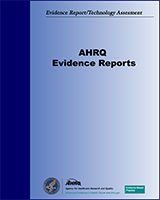NCBI Bookshelf. A service of the National Library of Medicine, National Institutes of Health.
Heidenreich PA, McDonald KM, Hastie T, et al. An Evaluation of Beta-Blockers, Calcium Antagonists, Nitrates, and Alternative Therapies for Stable Angina. Rockville (MD): Agency for Healthcare Research and Quality (US); 1999 Nov. (Evidence Reports/Technology Assessments, No. 10.)
This publication is provided for historical reference only and the information may be out of date.

An Evaluation of Beta-Blockers, Calcium Antagonists, Nitrates, and Alternative Therapies for Stable Angina.
Show detailsStable angina is a major health problem that affects over 7 million adults in the United States, with an estimated 350,000 new cases annually. The most common cause of angina is atherosclerotic obstruction of the major coronary arteries. Symptoms, which commonly occur for the first time during the fifth or sixth decade of life, result from an inadequate oxygen supply to the myocardium for a given demand. Thus, angina is often precipitated when a person exercises or is subjected to other stress. By definition, the symptoms of stable angina disappear with rest, thereby distinguishing it from unstable angina and myocardial infarction.
Patients with angina are at substantially higher risk of cardiac death or myocardial infarction than are members of the general population. Therapies for patients with stable angina are aimed at reducing symptoms, reducing the risk of death and myocardial infarction, or both. Therapies that act solely to reduce risk without changing symptoms are clearly important components of medical management but are not discussed in this review.
Symptomatic therapy is targeted at either reducing oxygen demand by decreasing the work of the heart or increasing oxygen supply by dilating coronary arteries (Karliner, 1991). Acute treatment of an episode of angina consists of rest and often includes sublingual nitroglycerin. Chronic treatment to prevent symptoms has consisted of one or a combination of beta-blockers, calcium antagonists, and long-acting nitrates (Gersh, Braunwald, and Rutherford, 1997). The choice of a first-line agent has been controversial because all three drug classes have been shown to be effective in relieving symptoms. Few long-term trials have evaluated the effect of these drugs in patients who have stable angina. Thus, it is unclear whether either of the drug classes improves survival or decreases events in this patient population. Because long-term use of beta-blockers has been shown to reduce mortality following myocardial infarction, researchers have suggested that these drugs also be used as first-line agents in patients with stable angina (Gersh, Braunwald, and Rutherford, 1997). However, calcium antagonists are often used as initial therapy because they are assumed to have equal efficacy in relieving angina and to be associated with fewer side effects than beta-blockers (Chan, Heo, Garibian, et al., 1988; Fox, Jespersen, Ferrari, et al., 1997). Furthermore, long-term nitrate therapy has been recommended as initial therapy by some investigators (Chan, Heo, Garibian, et al., 1988; Hoekenga and Abrams, 1984), but concern about the need for a daily nitrate-free period has led many physicians to use long-term nitrates as second-line agents (Gersh, Braunwald, and Rutherford, 1997). At this time, no single class of therapy has proved superior for treatment of chronic stable angina (Roberts, 1985; Thadani, 1997).
Calcium antagonists are more diverse than beta-blockers in chemical structure and mechanism of action. Short-acting agents such as dihydropyridines, particularly nifedipine, are distinct from other types of calcium antagonists in part because they generally increase rather than decrease heart rate. Recent case-control studies and meta-analyses of randomized trials suggested that short-acting calcium antagonists increase the risk of cardiac events among patients who have hypertension (Psaty, Heckbert, Koepsell, et al., 1995), and nifedipine increases risk of cardiac events following acute ischemic syndromes (Furberg and Psaty, 1996; Furberg, Psaty, and Meyer, 1995). These observations have led to considerable discussion and controversy. Even if the findings are valid in the populations studied, it is uncertain whether they can be extended to the stable angina patient population.
Although all three classes of anti-anginal agents have been proven safe and effective compared with placebo, the efficacy and safety of these agents when compared with one another is not clear. Furthermore, the majority of studies that have compared anti-anginal agents have been small and thus did not have the power to detect clinically important differences between therapies. To determine the relative efficacy and safety of anti-anginal therapies, investigators at the University of California, San Francisco (UCSF)-Stanford Evidence-based Practice Center (EPC) performed a meta-analysis of trials that directly compared beta-blockers, calcium antagonists, and long-acting nitrates in patients who had stable angina.
The American College of Cardiology, American Heart Association, and American College of Physicians established a committee to develop guidelines for the diagnosis and treatment of stable angina. This committee of experts in cardiology and internal medicine and investigators from the UCSF-Stanford EPC prioritized two topics for a thorough and systematic review of the literature. The first topic was designed to address the issue described above to determine the relative efficacy and safety of beta-blockers, calcium antagonists, and long-acting nitrates in patients who have stable angina. The second review examined the efficacy of alternative therapies in patients who have stable angina.
- Introduction - An Evaluation of Beta-Blockers, Calcium Antagonists, Nitrates, an...Introduction - An Evaluation of Beta-Blockers, Calcium Antagonists, Nitrates, and Alternative Therapies for Stable Angina
- Appendix C. Contributors - Milk Thistle: Effects on Liver Disease and Cirrhosis ...Appendix C. Contributors - Milk Thistle: Effects on Liver Disease and Cirrhosis and Clinical Adverse Effects
- Appendix A. Milk Thistle Search Strategies - Milk Thistle: Effects on Liver Dise...Appendix A. Milk Thistle Search Strategies - Milk Thistle: Effects on Liver Disease and Cirrhosis and Clinical Adverse Effects
- References - An Evaluation of Beta-Blockers, Calcium Antagonists, Nitrates, and ...References - An Evaluation of Beta-Blockers, Calcium Antagonists, Nitrates, and Alternative Therapies for Stable Angina
- Glossary - Diagnosis and Treatment of Acute Bacterial RhinosinusitisGlossary - Diagnosis and Treatment of Acute Bacterial Rhinosinusitis
Your browsing activity is empty.
Activity recording is turned off.
See more...